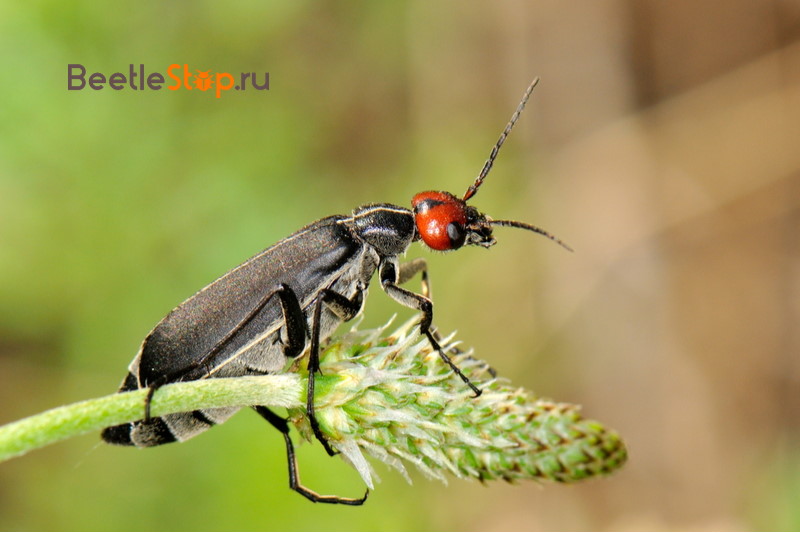A red-headed ballhead is a friend or an enemy of plants?
Bug bugs are brightly colored, warning others from contact with insects. Their secretions and hemolymph contain the toxic substance cantharidin, which causes severe poisoning when it enters the body and irritates the skin. The family has united more than 7,500 species, divided into genera. Representatives of the genera Lytta and Epicauta have an external resemblance, the second name of the beetle beetles. Adults feed on the green parts of plants, and the larvae destroy the locust egg capsules. Red-headed spanking is considered a dangerous pest of grain, industrial and vegetable crops. Adult individuals eat the leaves and flowers of plants, with mass reproduction destroy them completely.
Morphological description of the species
The red-headed plaque (Epicauta erythrocephalata) is a member of the bark family. The beetle is medium-sized 12-18 mm, the body is narrow and long. The head is a bright orange-red color, in the middle there is a black stripe. The eyes are oval, antennae 11-segmented. Pronotum already elytra. The main color is black, in the middle is a strip of light hairs. Elytra flexible, not reaching end of abdomen. Coloring is black, on the perimeter bordered by white, on the back there passes the same longitudinal strip. Light areas form hairs. The abdomen is covered with short gray hairs. In case of danger, the beetles secrete droplets of poisonous liquid from the joints of the limbs.

Distribution area
Pewter is a red-headed thermophilic species. Insects live in the south of Russia and Europe (Austria, Italy), in Kazakhstan, Central Asia, Turkey, Iran. Beetles are common in the south-west of Siberia.
Lifestyle & Reproduction
The adult guards are active from May to August. They are kept in large colonies, often found on crops: potatoes, soybeans, alfalfa, and melons. After mating, the females lay their eggs in moist soil. Punks choose places where locust pods are buried. Translucent oval eggs are laid in heaps. They ripen for 2-3 weeks, then larvae appear. In the first stage, these are campodeoid, motile triungulins. Dark, with long legs and tail processes. There are long crescent mandibles. Triungulins are active predators, distinguished by well-developed sensory organs. They cling to the capsules (cocoons) of desert locusts, Siberian filly and Prusiks, eat their eggs.
Inside the locust capsules, the triungulins molt and turn into a thick white larva with short legs and hairs on the body. On the free head there are 3-segmented antennae, mandible with two teeth. The abdomen consists of 10 segments. It feeds continuously, molts 3 times and becomes thicker and clumsy. The larva of an older age loses hairs, the head becomes reddish. Having eaten all the eggs, she gnaws the move from the egg capsule. In the earth turns into a false doll. At this stage, it is motionless, the body is curved, painted in orange. In this state, the insect easily suffers from a lack of moisture and other adverse conditions.
Information. In this state, the false pupa can remain for up to two years, immersed in diapause.
After wintering, molting occurs, the larva becomes mobile, leaves into the soil to create a puppet chamber. In the cradle it transforms into a white soft chrysalis. The phase takes 2-3 weeks, in May the first adults appear. The complex process of development of red-headed boils is called hypermetamorphosis. One generation develops per year, due to diapause, its development may drag on for 2-3 years.
Pests or Helpers
The greatest harm to plants is a flock of red-headed bobbins in dry years, eating completely leaves, flowers and young twigs. At the same time, the larvae of narcotics destroy the offspring of locusts eating all plants within reach. These beetles are of great benefit. It was noted that the mass appearance of bobbins is associated with a previous increase in the number of locusts and prus.
Information. Poisonous beetles are dangerous for cattle and other animals. When eaten together with grass, they cause serious poisoning.
Methods of struggle
The plaques help control the numbers of locusts and Italian prus. Usually the benefits of insects exceed the possible harm. But in large quantities, the red-headed plume presents a danger to vegetable gardens and fields. To combat it, agricultural methods are used:
- autumn plowing;
- weed control.
In the infield, the bobbins are manually collected and destroyed. Work is carried out in the early morning, be sure to wear gloves that protect the skin. In some cases, plants have to be treated with insecticides.

